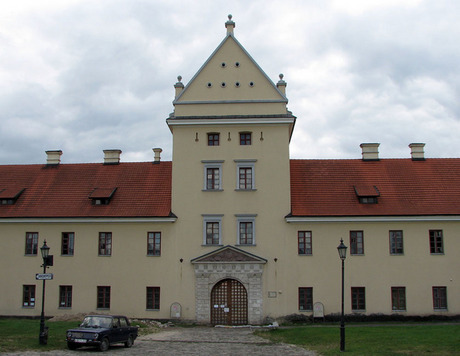Zhovkva Castle
Numerous Ukrainian towns and villages can boast of having the remnants of ancient fortifications, but only the small district centre of Zhovkva in the Lviv region has an absolute right to call its fortress "ideal". At this location, in the first half of the XVII century the only mint in the territory of Ukraine was in operation with the coins being minted from silver that belonged to the Hetman Zolkiewski’s widow.
This is another of the Lviv region castles connected to Poland’s King Jan III Sobieski, who made it one of his regional residences in the latter half of the seventeenth century. Zhovkva is noted for the remains of fortifications including the Glynska and Zwirynetska Gates, the castle itself and the cathedral and bell tower. Also of worth seeing are the Dominican and Basilian monasteries, the wooden churches and the giant synagogue. Zhovkva is an excellent example of the unique architectural style of a 17th century fortress town and offers a window into the imperial aspirations of the Polish rulers who built it.
With each change in history this town changed its name and appearance. However the centre is the same as in medieval times and is again called Zhovkva (Zolkiew in Polish). In 1594 the great Hetman Stanislas Zolkiewski (1547–1620) transformed the village of Vynnyky into a town-fortress. And in 1603 after victory over Revel, Polish King Sigmund ІІІ gave the town the Magdeburg charter and named it “Zolkiew" (Zhovkva).
Influenced by Thomas More's “Utopia” many “ideal” towns were built in Europe at that time. Based on a project by Italian architect B. Morando, well-known Lviv craftsmen Paweł Szczęśliwy (Shchastlyvyy), Paweł Rzymianin and Ambroży Przychylny tried to build an "ideal" Zhovkva. The centre of their attention was the castle.
Construction of the castle began in the early 17th Century. Behind the castle was a zoo which is a park today. Stanislav Zholkievski founded Zhovka in 1594 on the site of the 14th-Century Kyivan-Rus village of Vynniky. His wife, Regina, managed the building of the fortress since her husband was gone most of the time at war as Field Crown Hetman of Poland. From 1594-1596 he put down the Cossack uprising of Severyn Nalyvaiko. In 1607 he defeated the rebel nobles who tried to overthrow Polish King Sigismund III Vasa at the Battle of Guzow. His greatest victory came in 1610 when he defeated the Russian forces at the Battle of Klushino and subsequently captured Moscow and dethroned Tsar Vasiliy Shuyskiy, briefly detaining him in Zhovka Castle. Both in 1612 and 617 he led military campaigns into Moldavia against their Turkish overlords. In the midst of these military victories Zhovka received Magdeburg Law in 1603.
It was his third campaign in Moldavia against the Turks in 1620 that brought about his death. The Polish-Lithuanian army, with their Cossack and Moldavian allies, met the Ottoman and Tatar forces led by Iskender Pasha on September 10. The Turkish forces surprised the Commonwealth forces and many were taken captive. The Moldavians quickly changed sides and attacked the Polish army as well. By September 19 the Commonwealth leaders realized they had lost and began to prepare for their retreat that took place ten days later. The retreat, under constant attack, was holding until the night of October 6 when the nobles attempted to flee north leaving the army and camp behind. The Turks swooped in and slaughtered the leaderless army. Zholkievski was captured and beheaded. His head was mounted on a pike and sent back to the Sultan. His son, also named Stanislav, was captured and imprisoned by the Turks. The Commonwealth raised a ransom to redeem his head and secure the release of his son. The son died soon afterwards with no heir. The Zhovka Castle then was passed to the prominent Danylovych family. Cossack hero Bogdan Khmelnitsky spent his first ten years in Zhovka (1595-1605). His father, Mykhailo Khmelnitsky, was the sotnik (military secretary) to Zholkievski. The town of Zhovka reached its heights at the end of the 17th century when Polish King Jan III Sobieski.
During 1604–1609 the Roman-Catholic church of St. Lavrentiy (Laurence) appeared there. It became a peculiar necropolis of the Sobesky and the Zolkiewski families. There was a publishing-house in the town, five large cloisters and a Jewish religious centre and two synagogues were situated there. The Zhovkva painting and carving school became a baroque leader in the territory of western Ukraine.
During the Northern War in 1706–1707 Tsar Peter І placed his residence in the castle and right here a historic Zhovkivskyy plan that helped to win a victory over the Swedes was developed. Ukrainian hetman Ivan Mazepa also visited this place.
In 1741-1742 Italian architect Antonio Kastelli, commissioned by the new owner Mychal Radziwill, expanded the palace from the stronghold, decorating the portico and the staircase with the sculptures of Lithuanian and Polish crown hetmans. But shortly after that the castle was out of History's favor for nearly two centuries and it only once regained its glorious past. In 1809 there was a solemn ball in honor of Napoleon Bonaparte. The next owner of the castle was the author Glodowski. In 1887 he sold one by one some of the walls, arcades, portico with the sculptures and one castle tower …to be used as building materials. And in 1915 a fire broke out.
Today Zhovkva is rising from the ruins. The state historical-architectural reserve is there and includes 55 architectural monuments, prominent monuments of the city's buildings, landscape architecture and also 15 historical monuments. And a glorious castle watches silently all these.
The best way to get to Zhovkva is through flight to Lviv. From Lviv to Zhovkva (32 km) you can get by taxi or public transportation. A walk from Zhovkva station where you arrive, to the castle, takes no more than 10 minutes. The town is small enough and all its sightseings are located close to one another.




